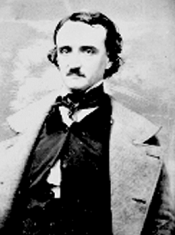

Mors dira fuit, vita salusque patent.

"Where grim death has been, life and health appear."
The short story, The Pit and the Pendulum by Edgar Allan Poe,
remains a masterful work of psychological narrative writing, but for the
careful reader, it also is a wonderful source of some interesting
computational problems.
As the imprisoned narrator recalls various tortures, careful observations
about the size and physical properties of the pendulum that seems doomed
to slice him also allow him to focus his efforts to escape, if only there
is enough time left to effect a plan.
Knowing just how long or short a time the
prisoner had to escape can add to the growing sense of horror and suspense:
"I saw that some ten or twelve vibrations would bring the steel in actual contact with my robe- and with this observation there suddenly came over my spirit all the keen, collected, calmness, of despair."
How long will this despair last? Does Poe provide sufficient information for you to explore a range of values for the period of this pendulum?
We encourage you to explore these questions by
observing the differences between a simple pendulum and a physical pendulum.
Consider the expressions for the period of one oscillation for varions models:
- A simple pendulum of length L under the influence of
gravity g with small-angle oscillations:

- The same simple pendulum, when the oscillations are not so small:

- A physical pendulum of moment of inertia I
and total mass m rotating around
a point a distance h from the center of mass with small-angle
oscillations:

- The same physical pendulum when the oscillations are not so small:

In the expressions above, k is defined as:

[ Home | The Pit and the Pendulum Home | Index ]
[ Simulation Software ]
[ Fractal Modeling Tools | Baroceptor
Modeling | SimSurface ]
[ Gnuplot | GalaxSee
| Environmental Models | InteGreat ]
Last Update: August 11, 1997
Please direct questions and comments about this page to WebMaster@shodor.org
© Copyright 1997 The Shodor Education Foundation, Inc.
|



